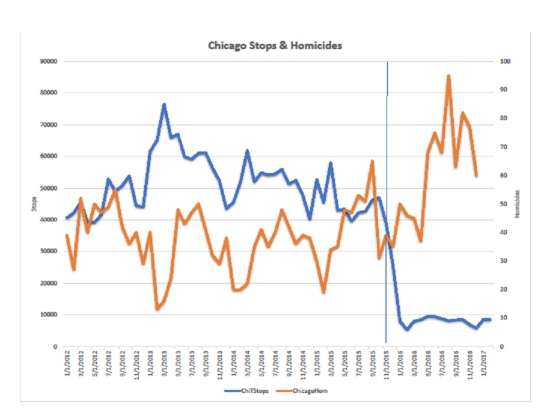The Volokh Conspiracy
Mostly law professors | Sometimes contrarian | Often libertarian | Always independent
The 2016 Chicago Homicide Spike - Explained
After an ACLU consent decree with the Chicago Police Department dramatically reduced the number of stop and frisks, homicides significantly increased as a result.
As the Chicago Tribune reported this morning, University of Utah Economics Professor Richard Fowles and I have just completed an important article on the 2016 Chicago homicide spike. Through multiple regression analysis and other tools, we conclude that an ACLU consent decree trigged a sharp reduction in stop and frisks by the Chicago Police Department, which in turn caused homicides to spike. Sadly, what Chicago police officers dubbed the "ACLU effect" was real—and more homicides and shootings were the consequence.
The analysis is relatively straightforward. It is well known that homicides increased dramatically in Chicago in 2016. In 2015, 480 Chicago residents were killed. The next year, 754 were killed—274 more homicide victims, tragically producing an extraordinary 58% increase in a single year. What happened?
Many commentators have observed this startling year-to-year change in homicides. However, a surprising lack of empirical effort has been devoted to exploring the causal factor or factors. This issue is, to put it bluntly, of life or death importance. Against a frightening backdrop of an annual baseline of about 500 homicides in Chicago each year, something in 2016 led to the death of more than 250 additional victims in a single year.
In our paper, Professor Fowles and I bring empirical research tools to bear in an attempt to identify what changed in Chicago during that time. While such analysis may be unable to provide absolutely definitive answers, it can suggest which factors are more likely than others to have been responsible. Given that, quite literally, more than two hundred additional victims died in 2016 in some of Chicago's most impoverished neighborhoods—and more might similarly be killed in the future in Chicago and elsewhere—finding answers must be regarded as a high priority.
Our article proceeds in several steps. It begins by describing in general terms what is quite accurately called a "spike" in homicides in Chicago in 2016. A 58% year-to-year change in America's "Second City" is staggering, suggesting something changed dramatically to initiate the increase.
We next attempt to pinpoint the time when things changed in Chicago—what might be called the "inflection" or "break" point in the data series. We begin by seasonally adjusting Chicago homicide and shooting data, which show significant seasonal fluctuation from cold weather months to warm weather months. Once the data are seasonally adjusted, a change or "break" in the data series can be statistically detected around November 2015.
We next explore the possibility that, as been suggested by a number of observers, a reduction in stop and frisks by the Chicago Police Department that began at the very end of 2015 was responsible for the homicide spike starting immediately thereafter. Good reasons exist for believing that the decline in stop and frisks caused the spike. Simple visual observation of the data suggests a cause-and-effect change. In the chart below, we depict the (seasonally unadjusted) monthly number of stop and frisks (in blue) and the monthly number of homicides (in gold). The vertical line is placed at November 2015—the break point in the homicide data. This is precisely when stop and frisks declined in Chicago.

Detailed regression analysis of the homicide (and related shooting) data strongly supports what visual observation suggests. Using monthly data from 2012 through 2016, we are able to control for such factors as temperature, homicides in other parts of Illinois, 9-1-1 calls (as a measure of police-citizen cooperation), and arrests for various types of crimes. Even controlling for these factors, our equations indicate that the steep decline in stop and frisks was strongly linked, at high levels of statistical significance, to the sharp increase in homicides (and other shooting crimes) in 2016.
We also explain why the possibly contrary experience with reductions in stop and frisks in New York City may be exceptional and inapplicable to Chicago and other cities. New York has comparatively low levels of gun violence—and stop and frisk tactics may be particularlyl important for deterring gun crimes.
We then qualitatively search for other possible factors that might be responsible for the Chicago homicide spike. For various reasons, none of these other candidates fit the data as well as the decline in stop and frisks. In addition, Bayesian Model Averaging ("BMA") provide strong statistical evidence that our findings are robust in the sense that they are not due to inclusion or exclusion of any particular variables in our equations.
Our equations permit us to quantify the costs of the decline in stop and frisks, both in human and financial terms. We conclude that, because of fewer stop and frisks in 2016, a conservative estimate is that approximately 236 additional homicides and 1115 additional shootings occurred during that year. A reasonable estimate of the social costs associated with these additional homicides and shootings is about $1,500,000,000. And these costs are heavily concentrated in Chicago's African-American and Hispanic communities.
In our penultimate section, we explain why the ACLU settlement agreement with the Chicago Police Department is the most likely cause of the decline in stop and frisks. Indeed, the ACLU took credit for the decline in stop and frisks at the start of 2016.
We conclude by offering some tentative suggestions for how policy-makers might reassess the importance and benefits of stop and frisk practices on the streets of Chicago and other cities. We also situate our findings within a larger body of developing empirical literature supporting the conclusion that restrictions on law enforcement investigations has real-world consequences by reducing police effectiveness. Sadly, Chicago's 2016 homicide spike may be a reflection of the tragic consequences that follow when that linkage is ignored.
This short summary cannot capture all parts of our analysis, so for all the details, download the full paper here.


Show Comments (207)